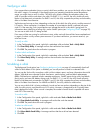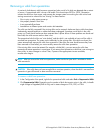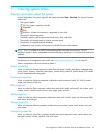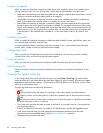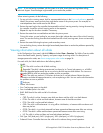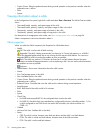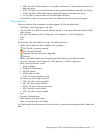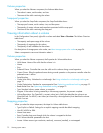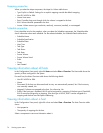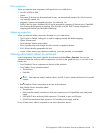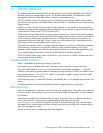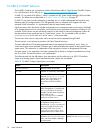72 Viewing system status
Volume properties
When you select the Volumes component, the Volumes table shows:
• The volume’s name, serial number, and size
• The name of the vdisk containing the volume
Snap-pool properties
When you select the Snap Pools component, the Snap Pools table shows:
• The snap pool's name, serial number, size, and free space
• The quantity of master volumes and snapshots associated with the snap pool
• The name of the vdisk containing the snap pool
Viewing information about a volume
In the Configuration View panel, right-click a volume and select View > Overview. The Volume Overview
table shows:
• The capacity and space usage of the volume
• The quantity of mappings for the volume
• The quantity of task schedules for the volume
For descriptions of storage-space color codes, see About storage-space color codes on page 26.
Select a component to see more information about it.
Volume properties
When you select the Volume component, the Properties for Volume table shows:
• Vdisk Name. Name of the vdisk that the volume is in.
• Name.
• Size.
• Preferred Owner. Controller that owns the vdisk and its volumes during normal operation.
• Current Owner. Either the preferred owner during normal operation or the partner controller when the
preferred owner is offline.
• Serial Number.
• Cache Write Policy. Write-back or write-through. See Using write-back or write-through caching on
page 19.
• Cache Optimization. Standard or super-sequential. See Optimizing read-ahead caching on page 19.
• Read Ahead Size. See Optimizing read-ahead caching on page 19.
• Type. Standard volume, master volume, or snapshot.
• Progress. If the volume is being created by a volume-copy operation, the percent complete.
• Volume Description. For OpenVMS, a numeric value (set in SMU) that identifies the volume to an
OpenVMS host. For HP-UX, a text value (set in-band by a host application) that identifies the volume.
Blank if not set.
Mapping properties
When you select the Maps component, the Maps for Volume table shows:
• Type. Explicit or Default. Settings for an explicit mapping override the default mapping.
• Host ID. WWPN or IQN.
• Name. Host name.
• Ports. Controller host ports through which the volume is mapped to the host.
• LUN. Volume identifier presented to the host.
• Access. Volume access type: read-write, read-only, no-access (masked), or not-mapped.



